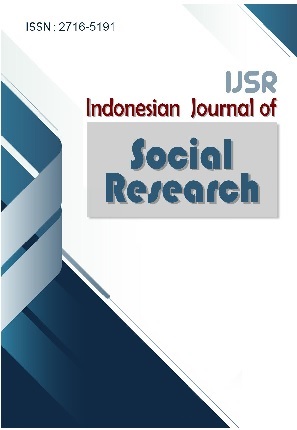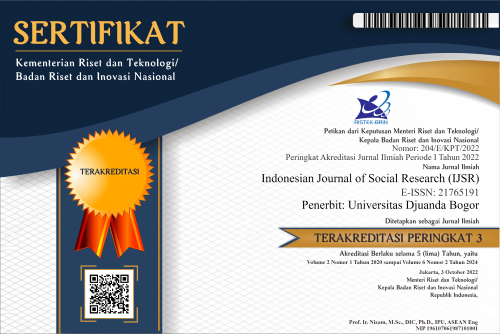Determinants of Customer Retention in Cellular Industry of Bangladesh: A Study on Young Customers
Abstract
The telecommunication industry in Bangladesh, with the global trends, has been considerably grown up during the last two decades. At the end of December 2020, the number of cellular phone subscribers reached 170.137 million under four operators in the country. The telecommunication industry has been experiencing increased competition because the government has introduced uniform call rates for all operators and launched mobile number portability (MNP) in 2018, resulting in an easy switching for a customer to other operators. This situation has originated a great challenge for the cellular service providers in Bangladesh to retain the existing customers, especially the young subscribers who have more switching trends. The hyper-competition in the industry also induced mobile operators to work hard to attract new customers and retain the existing ones. The paper, therefore, aims to find out the determinants of young customer retention in the cellular industry of Bangladesh. This study is exploratory based on primary data collected from 415 young cellular phone users of the age of below 40 years in the two largest cities (Dhaka and Chittagong) in Bangladesh. The study examined eight determining factors of customer retention using the statistical tools: mean and standard deviation. The study found that price perception, customer satisfaction, switching barriers, and brand image are the strongest customer retention determinants. This study's findings have important implications for cellular phone operators to tailor their services and strategic priorities for maximizing customer satisfaction, loyalty, and retention to gain market growth and higher returns.
References
Ali, J. F., Ali, I., & Afzal, H. (n.d.). Determinants of consumer retention in cellular industry of Pakistan. Afr. J. Bus. Manage., 7.
Almossawi, M. M. (2012). Customer Satisfaction in the Mobile Telecom Industry in Bahrain: Antecedents and Consequences. International Journal of Marketing Studies, 4(6), p139. https://doi.org/10.5539/ijms.v4n6p139
Alshurideh, M. (2016). Scope of Customer Retention Problems in the Mobile Phone Sector: A Theoretical Perspective. 7.
Alvarez, E. J. (2001). Your Bank's Image: Keeping it Consistent. Bank Marketing, 33(3), 30-35.
Anderson, E. W., Fornell, C., & Mazvancheryl, S. K. (2004). Customer Satisfaction and Shareholder Value. Journal of Marketing, 68(4), 172–185. https://doi.org/10.1509/jmkg.68.4.172.42723
BTRC. (2021). Subscribers Information. Retrieved on March 30, 2021 from http://www.btrc.gov.bd/telco/mobile
Burnham, T. A., Frels, J. K., & Mahajan, V. (2003). Consumer Switching Costs: A Typology, Antecedents, and Consequences. Journal of the Academy of Marketing Science, 31(2), 109–126. https://doi.org/10.1177/0092070302250897
Christopher, M., Peck, H., & Towill, D. (2006). A taxonomy for selecting global supply chain strategies. The International Journal of Logistics Management, 17(2), 277–287. https://doi.org/10.1108/09574090610689998
Colgate, M., & Norris, M. (2001). Developing a comprehensive picture of service failure. International Journal of service industry management.
Danish, R. Q., Ahmad, F., Ateeq, A., Ali, H. Y., & Humayon, A. A. (n.d.). Factors Affecting Customer Retention in Telecom Sector of Pakistan. 10.
EBL Securities. (2019). Bangladesh telecommunication industry: a comprehensive review. Retrieved on March 30, 2021 from http://www.eblsecurities.com/AM_Resources/AM_ResearchReports/SectorReport/Bangladesh%20Telecommunication%20Industry-A%20Comprehensive%20Review%202019.pdf
Gerpott, T. J., Rams, W., & Schindler, A. (2001). Customer retention, loyalty, and satisfaction in the German mobile cellular telecommunications market. Telecommunications Policy, 25(4), 249–269. https://doi.org/10.1016/S0308-5961(00)00097-5
Gounaris, S. P. (2005). Trust and commitment influences on customer retention: insights from business-to-business services. Journal of Business research, 58(2), 126-140.
Gupta, S. (2002). Strategic dimensions of corporate social responsibility as sources of competitive advantage via differentiation. Unpublished Doctoral Dissertation, Temple University, USA.
Hanif, M., Hafeez, S., & Riaz, A. (2010). Factors Affecting Customer Satisfaction. 60, 10.
Hansemark, O. C., & Albinsson, M. (2004). Customer satisfaction and retention: the experiences of individual employees. Managing Service Quality: An International Journal.
Hess, M., & Ricart, J. E. (2002). The Quest for Customer Loyalty in the Mobile Phone Operator Industry. The European Academy of Management.
Jones, M. A., Taylor, V. A., Becherer, R. C., & Halstead, D. (2003). The impact of instruction understanding on satisfaction and switching intentions. Journal of consumer satisfaction, dissatisfaction and complaining behavior, 16, 10.
Kim, Y.-E., & Lee, J.-W. (n.d.). Relationship between corporate image and customer loyalty in mobile communications service markets. Afr. J. Bus. Manage., 7.
Kukar-Kinney, M., Xia, L., & Monroe, K. B. (2007). Consumers’ perceptions of the fairness of price-matching refund policies. Journal of Retailing, 83(3), 325–337. https://doi.org/10.1016/j.jretai.2007.03.005
Kotler, P., & Armstrong, G. (2010). Principles of marketing. Pearson education.
Lee, J., Lee, J., & Feick, L. (2001). The impact of switching costs on the customer satisfaction‐loyalty link: Mobile phone service in France. Journal of Services Marketing, 15(1), 35–48. https://doi.org/10.1108/08876040110381463
Leelakulthanit, O., & Hongcharu, B. (2011). FACTORS THAT IMPACT CUSTOMER SATISFACTION: EVIDENCE FROM THE THAILAND MOBILE CELLULAR NETWORK INDUSTRY. 4(2), 11.
Lin, H.-H., & Wang, Y.-S. (2006). An examination of the determinants of customer loyalty in mobile commerce contexts. Information & Management, 43(3), 271–282. https://doi.org/10.1016/j.im.2005.08.001
Malhotra, N. K., & Dash, S. (2016). Marketing Research an Applied Orientation.
Mittal, V., Anderson, E. W., Sayrak, A., & Tadikamalla, P. (2005). Dual Emphasis and the Long-Term Financial Impact of Customer Satisfaction. Marketing Science, 24(4), 544–555. https://doi.org/10.1287/mksc.1050.0142
Mohd Kassim, N., & Souiden, N. (2007). Customer retention measurement in the UAE banking sector. Journal of Financial Services Marketing, 11(3), 217–228. https://doi.org/10.1057/palgrave.fsm.4760040
Mokhlis, S., Mat, N. H. N., & Salleh, H. S. (n.d.). Commercial Bank Selection: The Case of Undergraduate Students in Malaysia. 14.
Mouri, N. (n.d.). A Consumer-based Assessment Of Alliance Performance: An Examination Of Consumer Value, Satisfaction And Post-purchase Behavior. 157.
Peng, L. Y., & Wang, Q. (2006). Impact of Relationship Marketing Tactics (RMTs) on Switchers and Stayers in a Competitive Service Industry. Journal of Marketing Management, 22(1–2), 25–59. https://doi.org/10.1362/026725706776022263
Qadri, U. A., & Khan, M. M. S. (2014). Factors Affecting On Customer Retention: A Case Study of Cellular Industry of Pakistan. 1(1), 23.
Rahman, Md. H. (2014). FACTORS AFFECTING CUSTOMER SATISFACTION IN MOBILE TELECOMMUNICATION INDUSTRY IN BANGLADESH. Business, Management and Education, 12(1), 74–93. https://doi.org/10.3846/bme.2014.06
Ranaweera, C., & Prabhu, J. (2003). The influence of satisfaction, trust and switching barriers on customer retention in a continuous purchasing setting. International journal of service industry management.
Roberts-Lombard, M. (2002). Marketing research: a Southern African perspective. Future Managers.
Ruiz Díaz, G. (2017). The influence of satisfaction on customer retention in mobile phone market. Journal of Retailing and Consumer Services, 36, 75–85. https://doi.org/10.1016/j.jretconser.2017.01.003
S. M. Ferdous Azam, & Khondaker Sazzadul Karim. (2017). Factors Influencing Customers’ Satisfaction On Bangladeshi Telecommunication Service Providers. https://doi.org/10.5281/ZENODO.1043600
Saha, N. K., Islam, Md. R., & Hoque, A. U. (2016). Factors Affecting Customers’ Satisfaction of Mobile Phone Subscribers: An Empirical Study on Mobile Telecommunication Industry in Bangladesh. International Journal of Business and Management, 11(6), 252. https://doi.org/10.5539/ijbm.v11n6p252
Saunders, M. N. K., Lewis, P., & Thornhill, A. (2009). Research methods for business students (5th ed). Prentice Hall.
Smith, P. R., & Zook, Z. (2011). Marketing communications: Integrating offline and online with social media (5th ed). Kogan Page.
Tähtinen, J., & Vaaland, T. I. (2006). Business relationships facing the end: why restore them?. Journal of Business & Industrial Marketing.
Valenzuela, F. (2005). Consumer Complaining Behavior: The Case of a South American Country, Chile. Contemporary Management Research, 1(1), 3–12. https://doi.org/10.7903/cmr.69
Xia, L., Monroe, K. B., & Cox, J. L. (2004). The Price is Unfair! A Conceptual Framework of Price Fairness Perceptions. Journal of Marketing, 68(4), 1–15. https://doi.org/10.1509/jmkg.68.4.1.42733
Zielke, S. (2008). Exploring asymmetric effects in the formation of retail price satisfaction. Journal of Retailing and Consumer Services, 15(5), 335-347.
Copyright (c) 2022 Indonesian Journal of Social Research (IJSR)

This work is licensed under a Creative Commons Attribution-ShareAlike 4.0 International License.
The Authors submitting a manuscript do so on the understanding that if accepted for publication, copyright publishing of the article shall be assigned/transferred to Indonesian Journal of Social Research (IJSR) Universitas Djuanda as Publisher of the journal. Upon acceptance of an article, authors will be asked to complete a 'Copyright Transfer Agreement'. An e-mail will be sent to the corresponding author confirming receipt of the manuscript together with a 'Copyright Transfer Agreement' form by online version of this agreement.
Indonesian Journal of Social Research (IJSR) Universitas Djuanda, the Editors and the Editorial Board make every effort to ensure that no wrong or misleading data, opinions or statements be published in the journal. In any way, the contents of the articles and advertisements published in the Indonesian Journal of Social Research (IJSR) Universitas Djuanda are sole and exclusive responsibility of their respective authors and advertisers.
Remember, even though we ask for a transfer of copyright, our journal authors retain (or are granted back) significant scholarly rights as mention before.
The Copyright Transfer Agreement (CTA) Form can be downloaded here: Copyright Transfer Agreement-IJSR 2020
The copyright form should be signed electronically and send to the Editorial Office e-mail below:
Dr. Rasmitadila, M.Pd (Editor-in-Chief)
Universitas Djuanda
Jl. Tol Jagorawi No.1, Ciawi, Kec. Ciawi, Bogor, Jawa Barat 16720
Website: http://journal.unida.ac.id/index.php/IJSR/index
Email: ijsr@unida.ac.id





4.png)



